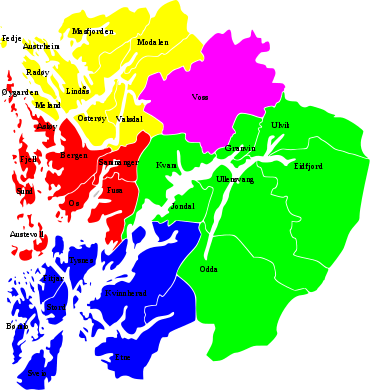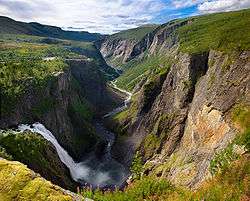Hordaland
Hordaland is a county (fylke) in West Norway. Hordaland stretches from the weather-beaten islands on the North Sea coast, through the gentle fertile slopes of the great fjords, toward alpine mountains with glaciers and high plateaus inland. Bergen—Norway's second city and an important destination—sits in the middle of the county, and other key settlements worth visiting are on the islands and along the fjords.
The name "Norway" ("way to the North") originally referred to the sea lane from somewhere around present-day Stavanger, through the political centres on Hordaland's coast, and further north.
Traditional Regions and their municipalities

| Nordhordland (Fedje, Austrheim, Radøy, Lindås, Meland, Vaksdal, and Masfjorden.) |
| Midhordland (Bergen, Austevoll, Os, Sund, Fjell, Øygarden, Askøy, and Samnanger.) |
| Hardanger (Kvam, Granvin, Ulvik, Eidfjord, Ullensvang, Odda, and Jondal.) the area defined by the grand, iconic Hardangerfjord |
| Sunnhordland (Sveio, Bømlo, Stord, Fitjar, Tysnes, Kvinnherad, and Etne.) Southern coastal region |
| Voss |
Cities and towns

- 🌍 Bergen - Norway's main city for several hundred years, and its second-largest today. Capital of Hordaland and West Norway. A city steeped in history and with a quirky charm.
- 🌍 Eidfjord - part of the great Hardangerfjord and home to Vøringsfossen waterfall and Hardangerjøkulen glacier
- 🌍 Finse - the highest station on the Bergen line, train access only, in Ulvik municipality
- 🌍 Kinsarvik administrative centre of the municipality of Ullensvang, see the Ancient masonry church and the nearby Hardanger bridge
- 🌍 Leirvik in Stord Municipality
- 🌍 Odda , visit Låtefossen waterfall, Trolltunga rock formation, and the monumental and stylish Tyssedal power plant
- 🌍 Rosendal administrative centre of the municipality of Kvinnherad
- 🌍 Stalheim in Voss Municipality
- 🌍 Ulvik
- 🌍 Vossevangen - a village and wide district in the centre of Hordaland, winter sport resort in Voss
Other destinations
Understand
- See also: Fjords of Norway
Hordaland is home some of Norway's iconic landscapes: grand fjords, fertile slopes and valleys, mountain plateaus, alpine summits, glaciers and countless islands. The terrain is extremely fragmented, particularly near the ocean, while the interior is more dominated by grand fjord/mountain landscapes. Hordaland includes the charming city of Bergen (Norway's main city for several hundred years) and other key settlements on islands and along fjords.
The county is administered and promoted by Hordaland Fylkeskommune Tel: +47 55 23 92 84, Fax: +47 55 23 90 01.
Get in
By boat
- Hurtigruten has Bergen as the final southern port
- Express passenger boats connects Bergen to Nordfjord and Sognefjord
- Ferries from Denmark via Stavanger arrives in Bergen
By plane

Hordaland has two airports of interest to the traveller:
- Bergen Airport, Flesland, (BGO IATA) Norway's second largest airport,has flights to all major and several smaller Norwegian airports; the Bergen-Oslo route is among the 10 most busy in Europe. It also has regular direct flights to many European destinations, as well as to Tokyo. Connections by bus to the town centre are frequent on the Flybussen Airport shuttle.
- Stord Airport (SRP IATA) is vastly smaller, and has regular flights to Oslo.
If going to the southern border of Hordaland, Haugesund airport (HAU IATA) in Rogaland can be considered.
By train
There are several departures every day between Bergen and Oslo on the Bergen Railway, and a long stretch of the railway line runs through Hordaland. Among the stations are Dale, Voss and Finse, which, at 1.222 metres above sea level is the highest station on the entire Norwegian rail network. Reservations on long-distance trains are compulsory in Norway. For this reason you should book ahead, especially on Fridays and Sundays as you may have trouble getting a seat or a sleeper.
There are local trains between Voss and Myrdal in Sogn og Fjordane county. Trains are operated by the Norwegian State Railways, NSB.
By car
By car, Hordaland can be entered from all its neighbouring counties, Rogaland, Sogn og Fjordane, Telemark, and Buskerud. From Oslo to north/central Hordaland including Bergen, the most common route in winter is following European route E16 through Akershus, Buskerud and Sogn og Fjordane. In summer, the route 7 is more common, at least after the opening of the Hardanger Bridge in 2013. The route 7 is shorter and faster but goes over the high mountain plateau and is affected by blizzards in winter. After the Hardanger Bridge use road 13 and E16 towards Bergen. From Oslo to south Hordaland, including Odda and Leirvik, route E134 is preferred.
From Hardanger, you can also drive along the Hardanger Fjord to Bergen. This road is a designated "National Tourist Road" by the Norwegian government, and goes through four small towns (Granvin proper, Øystese, Norheimsund and Samnanger) before meeting European route E16 just after entering Bergen municipality. You can also, instead of using the Hardanger Bridge, drive towards Odda. From Odda, you can continue following route 13 southwards into the southernmost part of Hordaland, Rogaland or Telemark. You can also drive through the Folgefonn tunnel, slightly north of Odda, and onwards to Rosendal and southern Hordaland.
Entering Hordaland from Rogaland (south) is rather straightforward. There are three alternatives; E39, the main road to Bergen from Stavanger, which leads through Stord and is rather ferry-heavy, and the aforementioned E134 and route 13, which both end up at Odda. The same can be said about entering from Sogn og Fjordane (north); there are two alternatives, E39, which runs near the coast and is, again, rather ferry heavy, and E16, which is the main road between Bergen and Oslo and is described above.
Get around
By ferry
Passenger boats along the coast are an option, especially if you are visiting islands such as Stord. Even if you are travelling by road, chances are good that you will come to a stretch of water where there is no bridge, and you will need a car ferry to get across. The frequency varies considerably, car ferries are part of the Norwegian road infrastructure and are usually, but not always, fairly frequent. The fast passenger boats are not so frequent. Most boats are operated by the transportation company Tide and schedules can be obtained from their website (unfortunately, only in Norwegian):
By bus
If you would like to travel by bus or coach, the national coach operator is called NOR-WAY Bussekspress. Further regional and local buses are managed by the public transport authority in Hordaland, Skyss on Public Service Obligations. Outside of Bergen and its vicinity you may find some lines to be rather infrequent. Some lines run only a handful of times per day, some only on schooldays and so on. Even so, the network does cover most areas.
By car
- See also: Driving in Norway
Where trains, boats and buses are not available, you will need to travel by car. Norwegian roads are frequently ridiculed for poor standards. The standard varies from location to location. There are motorways or multi-lane roads inside Bergen, while outside Bergen main roads are basically two-lane undivided. Some secondary roads are however so quite narrow. There countless tunnels and curves on all roads. Hordaland has 1/4 of Norway's more than 1000 tunnels. Car ferries are part of the road network.
As in the rest of Norway, renting a car is very expensive. However, as a car is needed to get to many rural areas, which are often the most interesting, renting one is still strongly recommended. All car rental companies present in Norway have offices in Bergen, at the airport and/or the city centre.
By train

Travelling on the small but scenic railways of Western Norway can be a scenic and breathtaking experience. Hordaland has one main line, Bergensbanen (Bergen line), connecting Bergen to Oslo via Voss, Hardangervidda (Finse station) and Geilo. Bergen line has a branch to Flåm (Flåmsbana, Flåm railway) with terminus at Flåm ferry dock. Flåm line connects to Bergen line at Myrdal station in the mountains. Bergen lin and in particular Flåm railway line were engineering achievments at the time of construction. Bergen line included the longest tunnel in Northern Europe. Flåm railway is one of the steepest adhesion lines but still has several switchbacks to climb the steep valley.
Local trains stopping at all stations are fairly frequent between Bergen and Voss and have open seating. There is also a shuttle between Bergen and Arna. Express trains the do not stop at all stations. Reservations on long-distance trains are compulsory in Norway. For this reason you should book ahead, especially on Fridays and Sundays as you may have trouble getting a seat. Trains are operated by the Norwegian State Railways, NSB.
See

- Flåm railway
Itineraries
- National tourist route Hardanger, roads 7, 13, 550 around Hardangerfjord
- National tourist route Hardangervidda, road 7 Hardangervidda continues towards Geilo
Do
Eat
Drink
Stay safe
Hordaland outdoor is very varied and partly rough. Do not walk on or close to glaciers on your own, go with a guide. Dont challenge the ocean waves. Keep a safe distance to waterfalls.
☎ Emergency numbers
.jpg)


- If you are unsure which emergency number to call, ☎ 112 is the central for all surch rescue services and will put you in contact with the correct department.
- For non-emergencies, the police is to be called on ☎ 02800 or Hordaland Police District at ☎ +47 55 55 63 00.
- The hearing impaired using a text telephone can reach the emergency services by dialing ☎ 1412.
- Roadside assistance is provided by Falck (☎ 02222) and Viking (☎ 06000). AAA members may call NAF on ☎ 08505.
Go next
- Sognefjord in Sogn og Fjordane - the great fjord county to the north
- Rogaland and Stavanger
- Buskerud and Hallingdal